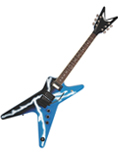Dean From Hell CFH Electric Guitar

Say the word “Dean” to your guitarist friends during a game of word association and chances are pretty damn good they’ll reply “Dimebag.” (If they say “Howard,” maybe they’re just pretending to be guitarists.) Dean Guitars enjoyed a very illustrious run during the late Seventies and early Eighties, but Dimebag Darrell kept the company’s image burning brightly from the early Nineties through the present day, introducing these ultracool guitars to a new generation of shredders and ax grinders. Dimebag played various Dean ML model guitars, but the one with a custom blue finish with white lightning bolts that Dime dubbed “The Dean from Hell” (featured on the cover of Pantera’s Cowboys from Hell) remains his most iconic ax. In 2005, Dean produced a limited run of 150 made-in-the-U.S.A. reproductions of Dime’s favorite ML, which sold out faster than a case of smuggled Twinkies at a teen weight-loss camp. But don’t despair if you missed the boat or couldn’t afford the $4,000 or so that these guitars sold for—Dean recently introduced the Dean from Hell CFH, an accurate reproduction of Dime’s most-beloved Dean that lists for a much more reasonable $1,625. FEATURES As you might have guessed, CFH stands for “Cowboy from Hell,” a fitting name for this truly wicked solidbody. From the glowing–lightning bolt finish to the riveted volume controls, the Dean from Hell has many of the details and distinctive touches as Dimebag’s original ax, sans the Kiss decal and years’ worth of wear and tear. But you don’t have to be in a Pantera tribute band to appreciate the CFH— it’s a devastating piece of heavy artillery that any shred warrior will be proud to add to his or her arsenal. The CFH has a mahogany body with a mahogany set-in neck mounted so seamlessly to the body that it seems as if the guitar is crafted from one continuous piece of wood. The neck features a bound rosewood fingerboard boasting simple dot inlays and smoothly polished jumbo frets. Chrome-plated Grover tuners grace the oversized V-shaped headstock. Dimebag’s “secret” weapon—a dualblade Bill Lawrence L-500XL humbucker—is mounted in the bridge position, and a specially designed Dean zebra-coil humbucker resides in the neck position. The matte-black licensed Floyd Rose double-locking tremolo is precisely mounted and set up, with the bridge cavity carved deep enough to permit extremely sharp pitch raising (essential for performing “Cemetery Gates”). The cavity is protected by a foam insert, which does limit the tremolo’s upward pitch range somewhat but also prevents the fine tuners from chewing up the body like a pack of rabid beavers.
PERFORMANCE Two major elements that characterized Dimebag’s sound were extreme overdrive with incredibly clear definition and his otherworldly command of harmonics all over the neck. Of course, his phenomenal technique had a lot to do with this, but having perfectly set up gear didn’t hurt either. This is where the CFH delivers in spades. When I mainlined the guitar to a Krank Krankenstein’s Dime channel and slapped up the gain, the Lawrence humbucker sang like the fat lady of the apocalypse. Treble notes delivered razor-sharp definition and cut, and bass notes roared like a Harley while remaining as tight and round as a supermodel’s backside. Even better, the Lawrence pickup captured even the most elusive “in-between” harmonics exceptionally well, generating squeals so high-pitched that dogs in the next county started to howl along. The neck-position Dean humbucker has noticeably lower output, but that’s a good thing if you want to be able to instantly switch from mellow, acousticlike chords and arpeggios to manic metal riffing and shredding at the flick of a pickup switch. The CFH is truly built for speed, and if you’ve got great technique and chops, its action and flat-but-chunky frets will whisk you along instead of slowing you down. And anyone who excessively abuses a Floyd Rose will appreciate the strips of electrical tape on the neck pickup that prevent loose strings from getting caught up in the coils. THE BOTTOM LINE The Dean from Hell CFH is a proper tribute to Dimebag and his Dean that shook the world. If you’re both a player and a Dimebag fan and want to experience some of Dime’s magic for yourself, the CFH is a must-have. DEAN GUITARS FOUNDER DEAN ZELINSKY DISCUSSES THE DEAN FROM HELL CFH Why are there DBD traction knobs only on the volume controls and not the master tone? Because that’s how it was on Darrell’s guitar, mostly because he did not use the tone control. Why are the neck pickup’s coils covered by electrical tape, while the bridge pickup’s are not? The tape is to keep the strings from getting caught under the pickup coils when you dive bomb the Floyd Rose. This is not a problem on the bridge pickup because of its proximity to the bridge. Dime used Seymour Duncan Dimebuckers on his later guitars. Why does the Dean from Hell CFH have his old favorite Bill Lawrence L-500XL in the bridge? Because that is the way the original Dean from Hell was and still is today.
Get The Pick Newsletter
All the latest guitar news, interviews, lessons, reviews, deals and more, direct to your inbox!
Chris is the co-author of Eruption - Conversations with Eddie Van Halen. He is a 40-year music industry veteran who started at Boardwalk Entertainment (Joan Jett, Night Ranger) and Roland US before becoming a guitar journalist in 1991. He has interviewed more than 600 artists, written more than 1,400 product reviews and contributed to Jeff Beck’s Beck 01: Hot Rods and Rock & Roll and Eric Clapton’s Six String Stories.
“It combines unique aesthetics with modern playability and impressive tone, creating a Firebird unlike any I’ve had the pleasure of playing before”: Gibson Firebird Platypus review
“This would make for the perfect first guitar for any style of player whether they’re trying to imitate John Mayer or John Petrucci”: Mooer MSC10 Pro review










